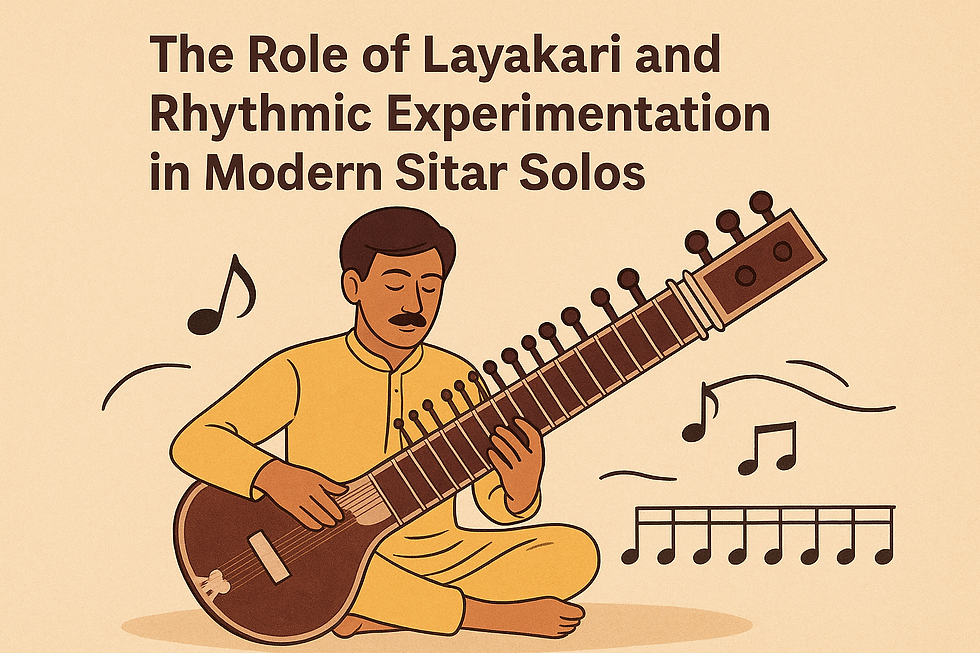"The Sitarist's Stepping Stones: Why Alankaras Are Your Daily Must-Do"
- Sharanya naidu
- Jun 12
- 3 min read
Updated: Jul 21
Namaste, aspiring sitarists! If you've just embarked on the incredibly rewarding journey of learning the Hindustani Sitar, you've probably already felt the magic of its resonant strings. But like any new adventure, a solid foundation is key. Today, we're going to dive into the bedrock of Hindustani classical music training: Alankaras.
Think of Alankaras as the fundamental building blocks of music. They are structured melodic patterns that help you develop finger dexterity, synchronize your right and left hands, improve your sense of swara (notes), and build a strong rhythmic understanding. While they might seem repetitive at first, mastering these exercises is crucial for unlocking the fluidity and expressiveness required for raags.

Why Alankaras are Your Best Friends
Finger Strengthening and Agility: Repeated practice of Alankaras builds muscle memory and strengthens the fingers of both your fretting and plucking hands.
Note Recognition and Ear Training: You'll start to internalize the relationships between notes and develop a keen ear for shruti (microtones).
Rhythmic Precision (Laya): Alankaras are often practiced with a taal (rhythmic cycle), which is indispensable for developing a strong sense of laya (tempo and rhythm).
Coordination: They help in synchronizing the movement of your plucking finger (using the mizrab) with your fretting fingers.
Preparation for Raags: The melodic phrases within Alankaras are often simplified versions of patterns you'll encounter in complex raags, preparing your mind and fingers for future challenges.
Getting Started: Your First Alankaras
We typically start with simple Alankaras based on the Bilawal Thaat, which is the equivalent of the Western major scale (all natural notes: Sa Re Ga Ma Pa Dha Ni Sa).
Here are a few basic Alankara patterns to get you started. Remember to practice these slowly and precisely, gradually increasing your speed as you become more comfortable. Use a tabla or metronome app to maintain a steady taal (e.g., Teentaal).
Let's denote the notes as:
Sa (C)
Re (D)
Ga (E)
Ma (F)
Pa (G)
Dha (A)
Ni (B)
Sa' (Higher C)
Alankara 1: Ascending and Descending in Single Notes
Aaroh (Ascending): Sa Re Ga Ma Pa Dha Ni Sa'
Avroh (Descending): Sa' Ni Dha Pa Ma Ga Re Sa
Practice tip: Ensure each note rings clearly. Focus on smooth transitions between notes.
Alankara 2: Stepwise Movement (Pairs)
Aaroh: Sa Re, Re Ga, Ga Ma, Ma Pa, Pa Dha, Dha Ni, Ni Sa'
Avroh: Sa' Ni, Ni Dha, Dha Pa, Pa Ma, Ma Ga, Ga Re, Re Sa
Practice tip: Pay attention to the consistent timing between each pair.
Alankara 3: Skipping Notes (Trio Patterns)
Aaroh: Sa Re Ga, Re Ga Ma, Ga Ma Pa, Ma Pa Dha, Pa Dha Ni, Dha Ni Sa'
Avroh: Sa' Ni Dha, Ni Dha Pa, Dha Pa Ma, Pa Ma Ga, Ma Ga Re, Ga Re Sa
Practice tip: This starts to challenge your finger independence. Focus on hitting the correct fret without fumbling.
Alankara 4: Combining Patterns
Aaroh: Sa Re Ga Re, Ga Ma Pa Ma, Pa Dha Ni Dha, Ni Sa' Re' Sa'
Avroh: Sa' Ni Dha Ni, Dha Pa Ma Pa, Ma Ga Re Ga, Ga Re Sa Re
Practice tip: These require more concentration and coordination. Break them down if necessary.
Important Considerations for Practice
Patience is Key: Don't get discouraged if you don't master them immediately. Consistency over speed is vital.
Slow and Steady: Always start slow. Accuracy at a slow tempo will naturally lead to accuracy at a faster tempo.
Posture: Maintain a relaxed and correct posture. Tension will hinder your progress.
Mizrab Technique: Focus on a clean and consistent stroke with your mizrab.
Listen Actively: Pay close attention to the sound you are producing. Is it clear? Is it in tune?
Guru's Guidance: While these exercises are fundamental, the guidance of a qualified Guru (teacher) is invaluable. They can correct your technique and introduce more complex Alankaras as you progress.
Daily Practice: Dedicate a specific time each day to your Alankara practice. Even 15-20 minutes daily is more effective than one long session once a week.
Beyond Bilawal Thaat
As you progress, your Guru will introduce Alankaras in other thaats (scales) and more intricate patterns, preparing you for the vast and beautiful world of raags. The discipline and precision you develop through Alankaras will serve as a strong foundation for your entire sitar journey.
So, pluck away, practice diligently, and enjoy the process of building your musical dexterity.
The sweet melodies of the sitar await your skilled touch!
Happy practicing!



Comments